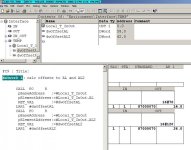Martin Nielsen
Member
[FONT="]Hi All
I managed to use SFB4 in a FC using the IN_OUT interface, but I would like to improve if possible.
Can I determine where the "timer area" starts?
The code seems to work perfect, but if the UDT is changed I would like the offset to change as well with a minimum of code change.
I want to get rid of those lines in my code:
L P#14.0
L P#22.0
I prefer "L First Timer" or similar
My UDT



 [/FONT]
[/FONT]
I managed to use SFB4 in a FC using the IN_OUT interface, but I would like to improve if possible.
Can I determine where the "timer area" starts?
The code seems to work perfect, but if the UDT is changed I would like the offset to change as well with a minimum of code change.
I want to get rid of those lines in my code:
L P#14.0
L P#22.0
I prefer "L First Timer" or similar
My UDT









